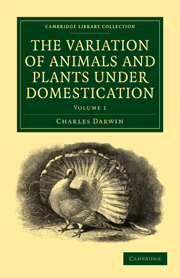Book contents
- Frontmatter
- Contents
- LIST OF ILLUSTRATIONS
- INTRODUCTION
- CHAPTER I DOMESTIC DOGS AND CATS
- CHAPTER II HORSES AND ASSES
- CHAPTER III PIGS — CATTLE — SHEEP — GOATS
- CHAPTER IV DOMESTIC RABBITS
- CHAPTER V DOMESTIC PIGEONS
- CHAPTER VI PIGEONS—continued
- CHAPTER VII FOWLS
- CHAPTER VIII DUCKS — GOOSE — PEACOCK — TURKEY — GUINEA-FOWL — CANARY-BIRD — GOLD-FISH — HIVE-BEES—SILK-MOTHS
- CHAPTER IX CULTIVATED PLANTS: CEREAL AND CULINARY PLANTS
- CHAPTER X PLANTS continued — FRUITS — ORNAMENTAL TREES — FLOWERS
- CHAPTER XI ON BUD-VARIATION, AND ON CERTAIN ANOMALOUS MODES OF REPRODUCTION AND VARIATION
CHAPTER III - PIGS — CATTLE — SHEEP — GOATS
Published online by Cambridge University Press: 05 October 2010
- Frontmatter
- Contents
- LIST OF ILLUSTRATIONS
- INTRODUCTION
- CHAPTER I DOMESTIC DOGS AND CATS
- CHAPTER II HORSES AND ASSES
- CHAPTER III PIGS — CATTLE — SHEEP — GOATS
- CHAPTER IV DOMESTIC RABBITS
- CHAPTER V DOMESTIC PIGEONS
- CHAPTER VI PIGEONS—continued
- CHAPTER VII FOWLS
- CHAPTER VIII DUCKS — GOOSE — PEACOCK — TURKEY — GUINEA-FOWL — CANARY-BIRD — GOLD-FISH — HIVE-BEES—SILK-MOTHS
- CHAPTER IX CULTIVATED PLANTS: CEREAL AND CULINARY PLANTS
- CHAPTER X PLANTS continued — FRUITS — ORNAMENTAL TREES — FLOWERS
- CHAPTER XI ON BUD-VARIATION, AND ON CERTAIN ANOMALOUS MODES OF REPRODUCTION AND VARIATION
Summary
The breeds of the pig have recently been more closely studied, though much still remains to be done, than those of almost any other domesticated animal. This has been effected by Hermann von Nathusius in two admirable works, especially in the later one on the Skulls of the several races, and by Rütimeyer in his celebrated Fauna of the ancient Swiss lake-dwellings. Nathusius has shown that all the known breeds may be divided in two great groups: one resembling in all important respects and no doubt descended from the common wild boar; so that this may be called the Sus scrofa group. The other group differs in several important and constant osteological charcters; its wild parent-form is unknown; the name given to it by Nathusius, according to the law of priority, is Sus Indica of Pallas. This name must now be followed, though an unfortunate one, as the wild aboriginal does not inhabit India, and the best-known domesticated breeds have been imported from Siam and China.
Firstly, the Sus scrofa breeds, or those resembling the common wild boar. These still exist, according to Nathusius (Schweineschädel, s. 75), in various parts of central and northern Europe; formerly every kingdom, and almost every province in Britain, possessed its own native breed; but these are now everywhere rapidly disappearing, being replaced by improved breeds crossed with the S. Indica form.
- Type
- Chapter
- Information
- The Variation of Animals and Plants under Domestication , pp. 65 - 102Publisher: Cambridge University PressPrint publication year: 2010First published in: 1868



